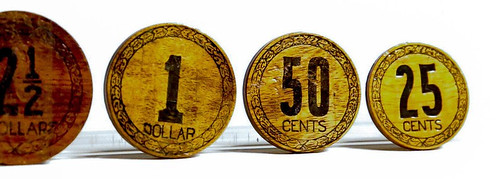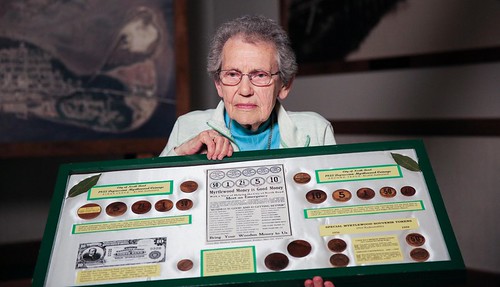
PREV ARTICLE
NEXT ARTICLE
FULL ISSUE
PREV FULL ISSUE
MYRTLEWOOD MONEY OF NORTH BEND, OREGONOregon Public Broadcasting published an excellent story this week about North Bend Oregon's Myrtlewood Money, a charming local depression scrip. Here's an excerpt. -Editor  Instead of her first week’s pay, her boss handed over a pair of coins. “So Duke said … ‘I’ll give you this coin that is more than 2,000 years old — from Europe — and here’s one of these $5 pieces that North Bend used to use — myrtlewood pieces. And you bring those back to me next week and then I’ll give you your salary.’” Pierce, whose mother was a coin collector, took the coins without any debate. She figured the Roman coin would make a valuable start to her own collection. She had no idea. The Roman coin turned out to be junk, not worth much due to its pervasiveness. But the myrtlewood coin — a $5 wooden piece given to her in 1948 — she still has it. It’s the anchor piece in her collection of North Bend’s one-of-a-kind currency, known locally as myrtlewood money. A local form of money that is still as good as cash in the boundaries of North Bend. Myrtlewood money’s story began in the early months of 1933. Life in America was hard in those days. The nation was in the midst of the Great Depression. Banks were foreclosing on farms and homes. Businesses were closing. Unemployment was estimated as high as 25 percent nationwide. And North Bend, a small timber and shipbuilding city on the Coos Bay, was not immune to the nation’s woes. In early January of that year, the town’s only bank announced a 30-day closure. It was intended as a measure to shore up the institution’s assets. But in the following weeks, no word came about when the bank would reopen. “The city had to scramble,” said retired North Bend High School teacher and Coos History Museum historian Steve Greif. “It had to pay its employees. It had firemen; it had police officers and city officials, a city manager; and they had to do something.” On March 10, 1933 — 59 days after the First National Bank closed its doors— the city announced a plan: North Bend would issue its own currency. The city planned to print $1,000 worth of its own scrip to help stimulate the flow of commerce. This wasn’t an original idea. All across the nation, towns and cities were dealing with a shortage of cash and a run on banks. Communities, municipalities, banks and community organizations began issuing their own currency to stimulate commerce. Most printed their money on paper or even wood. A few places got inventive. In Morrow County, Oregon, the town of Heppner printed money on strips of sheepskin. In California, the town of Pismo Beach decided to use clamshells as cash. North Bend settled on wood. But not just any wood. A rare type of beautiful hardwood grown locally made this small coastal city’s money a cut above the rest. “North Bend did it in a beautiful, artistic unique way,” Greif said. “I know other places made wooden money, but I don’t think anybody did it as beautiful as North Bend and did it quite as well.” North Bend got to work on getting the myrtlewood money into the hands of residents. The city chose a design and began work on issuing the first set of coins. Pressed on 1/4 inch-thick discs of myrtlewood in various diameters, the city’s new coins came in denominations of $10, $5, $2.50, $1 and 50 cents. Then-mayor Edgar McDaniel, who also served as editor of The Coos Bay Harbor, oversaw the printing of the coins on the paper’s presses and their distribution to the public. It didn’t take long for the myrtlewood money to catch on. “The newspaper advertised that it was good money, listed all the stores and people and the services in North Bend that would take the money, so it circulated a little bit,” Pierce recounted. City employees and contractors were paid with myrtlewood money, and they, in turn, spent it on goods and services throughout the community. Demand for the coins was high. Soon, the city decided to issue a second pressing of coins. Changes were made to the coins for the second issue. The city had learned valuable lessons during the first round of printing and distribution. Most notably, the design on the second issue was more intricate, with details more spread out across the full face of the coin. They also scrapped the $2.50 piece, replacing it with a quarter. The attention to design proved especially important for myrtlewood money’s fate. While the coins proved useful in keeping the economy moving, they also were gaining a reputation far and wide for their beauty. The rarity of the wood made counterfeiting the coins difficult, and collectors appreciated the attractiveness of the design. The coins were so popular that at one point the Klamath Falls Chamber of Commerce discussed the possibility of working with the North Bend Myrtlewood Factory to make money for their city. Collectors across the region clamored for the money. The word was out. The coins’ popularity, however, ultimately led to the currency falling out of circulation.  Pat Choat Pierce poses with her collection of the city’s myrtlewood money “When December came there really weren’t enough people who wanted their money that way,” Pierce said of the coins. “They were keeping it for souvenirs so the money has never been declared finished, even though it had a deadline time printed on it. It is still as good coinage today as it was back in 1933.” Ultimately, the coins’ beauty made it more valuable as a collectible than a currency. “That’s the beauty of myrtlewood is that no two coins are alike,” Greif said. “And that’s probably another reason that collectors think of them as being highly unique.” Nowadays, you’re unlikely to find someone actually willing to use these coins as cash, despite the fact that they remain legal tender within the city limits of North Bend. A $1 piece from the first issue sold in 2016 for $75 — a 7,400 percent premium over its declared value. “I would say at a minimum the most common are worth from $20 to $30 on the retail market,” said Wagner. “And the more expensive ones get you into the hundreds, and the rarest ones — the $10s — can’t be priced because they’re so rare that they just don’t trade.” To read the complete article, see: Here are some other articles about Myrtlewood Money. -Editor Wooden “D.I.Y. dollars” spend like the real thing in North Bend
(http://www.offbeatoregon.com/H1008e_north-bend-myrtlewood-money-still-legal-tender.html)  Wayne Homren, Editor The Numismatic Bibliomania Society is a non-profit organization promoting numismatic literature. See our web site at coinbooks.org. To submit items for publication in The E-Sylum, write to the Editor at this address: whomren@gmail.com To subscribe go to: https://my.binhost.com/lists/listinfo/esylum All Rights Reserved. NBS Home Page Contact the NBS webmaster 
|